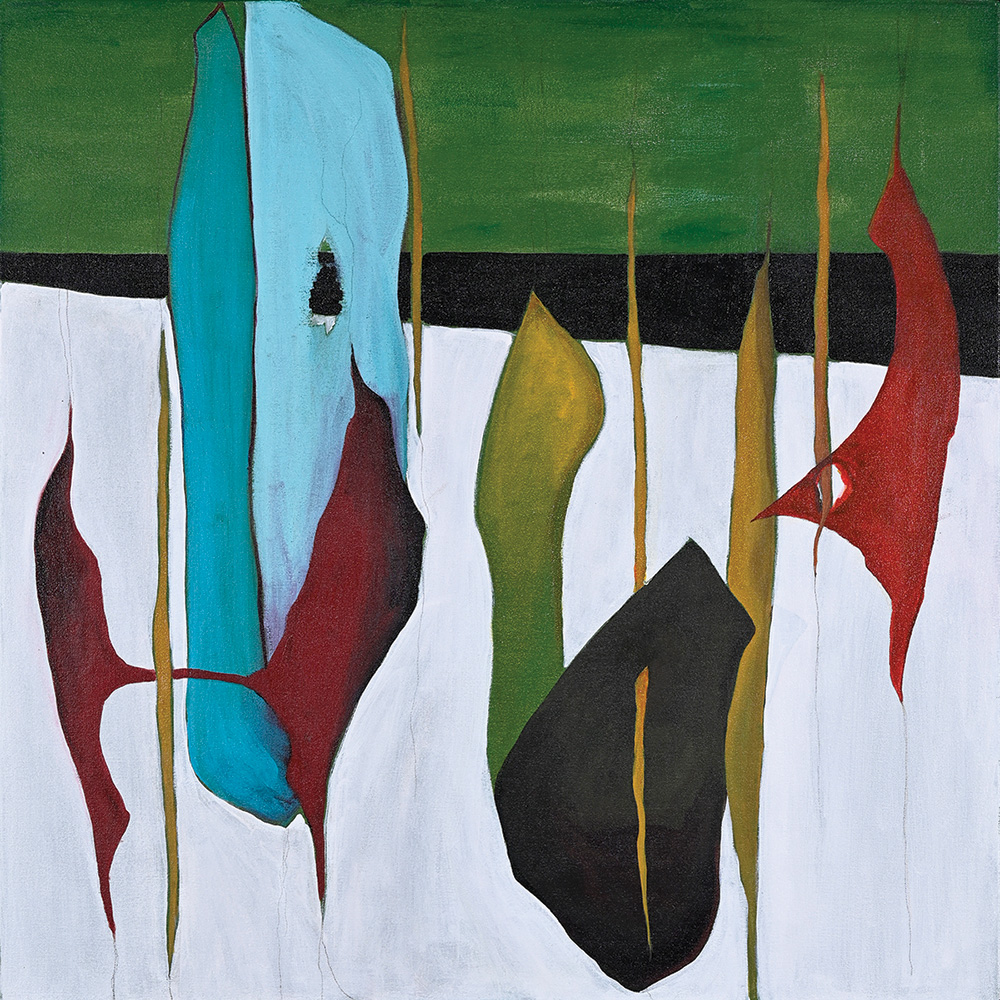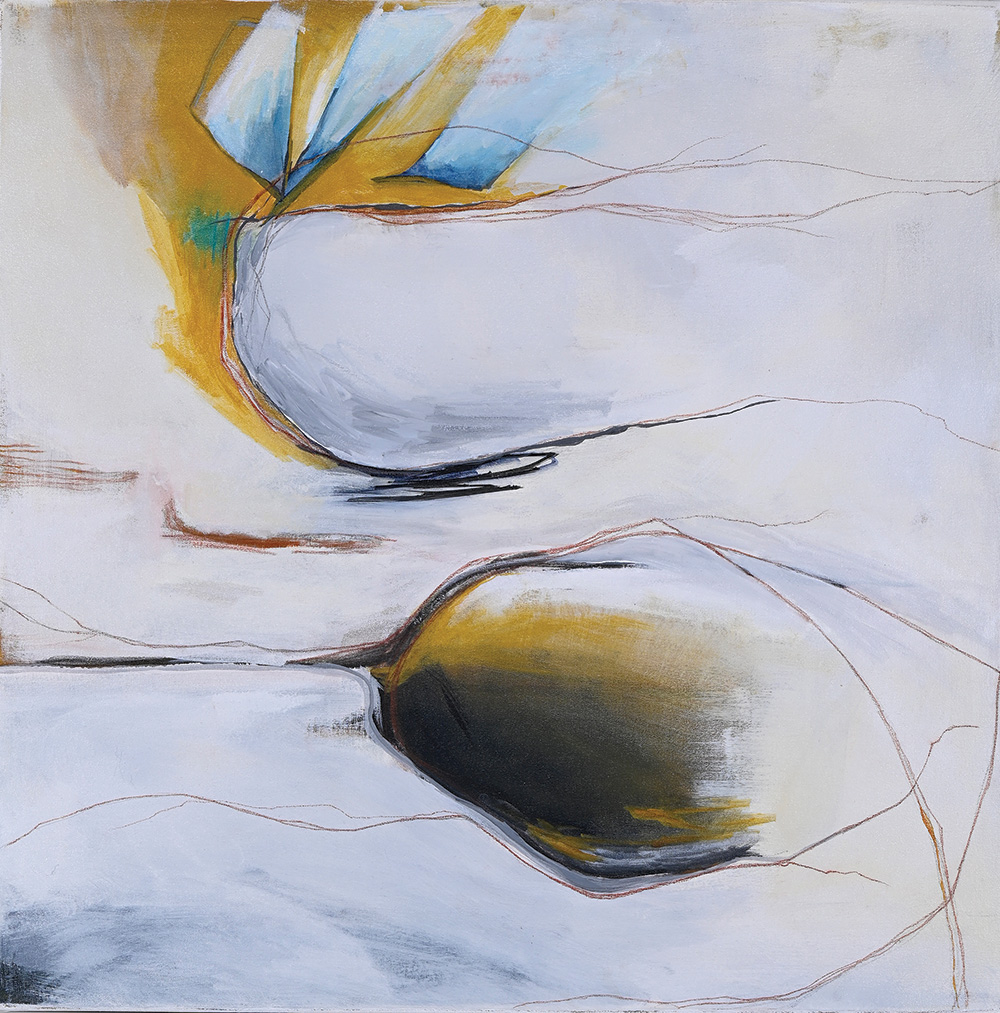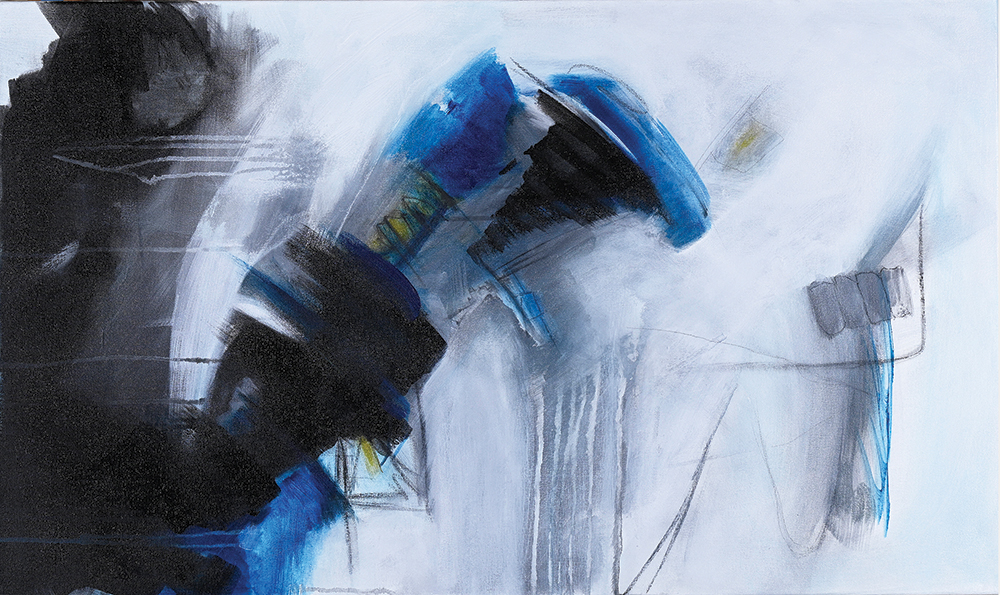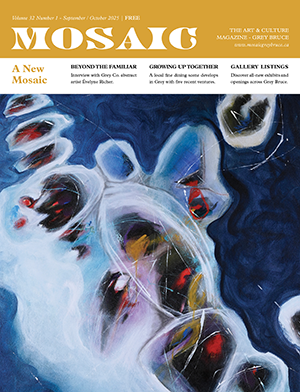Interview by Ken Bryson

Image courtesy of the artist.
Artist Évelyne Richer is commited to letting her art speak for itself. The career abstract painter – and long-time resident of Grey County – begins each painting with a concept, but ultimately the painting decides what it wants to be. From there, it’s up to the viewer. There’s no guessing what Grey County’s art community means to Richer, however. Read on to discover how the local scene has shaped her work and taken her art to a whole new level.
Abstract art has always been of interest to me, so I would like to understand a bit of your background and how you came to this style of art?
I’ve always been attracted to abstract art. There was something mysterious about it and I really wanted to relate to a form of art that made me think beyond the familiar. I love looking at nature and seeing the light, the vistas down to the minute details but it’s not how or what I wish to put on canvas or paper. I don’t want to copy what I see but maybe interpret it in some fluid upside down backwards way. I need to be intrigued I guess by how my eye and my hand are guided.
I want something new that comes out of my head, and so I think that’s why abstract was more my kind of thing. From the get-go, from the very beginning, I was like that. All these things speak to me more than trying to reproduce a flower that is spectacular, but it’s not what makes my heart sing.
Is your style something you developed on your own?
I really want to work with some new ideas that come out of nowhere, a way of using colour, form, line to make a statement. So shapes, colours, movement, all are shifting options especially in my paintings. I love to work spontaneously trusting the instinctive marks. It doesn’t always translate to a quick process though.
My monotypes are more controlled, slower and satisfying in a totally different way.
My style is in constant evolution. There’s a certain amount of abstract expressionism obviously but with each new work the approach is different. If I start a series of ten paintings let’s say, each one is related to the other like siblings, you can see the common thread but if I were to try and add to that series a few months or years later after I’ve closed the page it would be difficult.

Image courtesy of the artist.
In terms of your prior work, is this a place you’ve come to having gone through different styles?
My father was an avid amateur painter, classically trained and meticulous in his process. It’s funny how I became this unstructured, gestural, ’drips are great’ sort of painter.
I kept my hand in art as much as I could while bringing up a family and having a career, through drawing and painting courses (and even rather catastrophic glass blowing lessons) at Sheridan College.
I was greatly influenced by travels especially to Japan where minimalism, the art of restraint and simplicity seemed to suit my aesthetic at the time. On coming to Grey County I started working in larger formats with bolder shapes and colours, adding layers and nuances – basically finding my voice and the courage to explore it.
Again I am grateful especially to the people of Grey County who encouraged me to hang myself on a wall for others to examine and critique. Not for the faint of heart this business!
You have exhibited in galleries across Canada. Do people respond to your work differently in different areas?
My clients can be found throughout Ontario, Quebec, Alberta, England and the U.S. including city and local people.
I have to work a little harder here to reach an audience open to my style of work. Don’t get me wrong, there is a wealth of abstract aficionados out there but if you roam many of the small regional galleries, representational art outbalances non-objective art anytime. That’s just the way it is.
You just hope to help people be more comfortable over time with the less familiar.
How do you approach that challenge?
It still means you go on, bolder and braver with each new work. I work for myself first and foremost and hope to reach others as I press on.
It’s validating to be recognized and, if you can, to be commercially successful but that should not be the goal. I think that to be happy with your work, to find satisfaction in solving the puzzle of a composition or the perfect arrangement of colour and balance, to finally be able to say this work tells me it’s done, is ultimately my goal as an artist.
And to find a viewer who sees and feels their own interpretation in the work is also incredibly rewarding. It lets me know there was more to the work than what I alone could see in it. That is also why I hesitate to give most works a title. It is often too leading.

Image courtesy of the artist.
I understand you are part of the Walters Falls group of artists. How has that helped your work?
Great group of artists to be a part of. One that has continually evolved in its 28 years plus of history and has offered a high quality of work consistently from a very small but artistically rich geographical area. I’m fortunate to be part of the group.
Some of us get together once a week in my new studio. We’ve been doing this for years, and just like the show, the players or the location changes occasionally. It’s a great way to move ideas forward and see work as it evolves through someone else’s eyes. Critiquing is essential. We talk about art, trends, politics (sadly too much these days), techniques, anything and everything. Great fun!
In terms of your creative process, how does each painting come to you?
If there were a formula it would be helpful I guess, but each blank canvas, after I’ve stretched and gessoed it, stands as a challenge. Depending on the season, or the light, or my mood, or multiple other factors, that first mark will either pull it smoothly towards its final destination or start a very frantic process of emotional back and forth until it’s done. The initial concept often changes along the way. My hand might put down the paint, but as it progresses, the work takes on its own character, has its own voice.
There are moments of great tension and moments of total elation. I think those are the ingredients that make each work stand out from the last one.
When you show your art, is there something that you hope specifically the viewer is going to get out of it?
I think I mentioned before, that unless they are looking at the work and trying to find the literal meaning of the title, I like to see people come up with their own interpretation. It could be diametrically opposed to what I see in the work but to me that’s the beauty of abstraction. There could very well be as many meanings as there are viewers.
Also as they look at the work, I may encourage them to spin it around and see if it sits better in another direction. That in itself makes viewers consider the work from a different perspective, almost makes them participate in the creative process. A painting should never become static, every time you look at it it should reveal something, however insignificant.
You mentioned some other different media that you’re working in. Is that a direction you’re planning to go in?
Other than painting, whether on canvas, wood, paper or stainless steel, making prints and collages, I have worked with encaustic and assemblage. I love to give materials a second life as part of a work of art.
I want to try as many media as I can. I am not good at everything obviously, but the exploration itself is the goal: it offers me the opportunity to refine what I was already working with,or to take a new direction in my search for artistic fulfillment.
There is an essential curiosity that pushes me to forget limitations. I’d like to think that’s what being an artist is all about.
Evelyne Richer is an abstract painter in acrylics, a printmaker, sculptor/installation artist. She has shown at the Tom Thomson and Durham Galleries, Orillia Museum of Art and History among others. Her work can be found in Canada, the U.S and Britain. She is represented by the Craig Gallery in Meaford.
See more of Évelyne’s work this fall during the Autumn Leaves Studio Tour, from October 3rd to 5th. For more information and a map to all of the Autumn Leaves Studio Tour locations, visit ALST.ca

